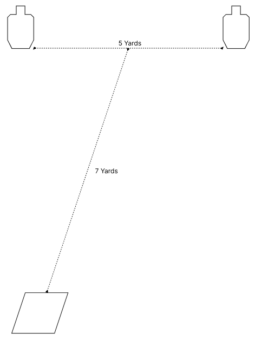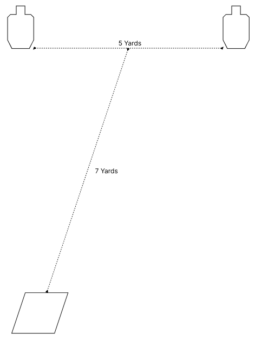How to Transition a Pistol Between Targets
Transitions are a valuable skill in of themselves, but the foundations provided by transitions also aid many other key skills.

Target transitions are an incredibly important skill for practical pistol shooting – yet for some reason they are often ignored by many firearms enthusiasts. I blame social media flashiness of the draw to first shot as well as single lane firing ranges. It’s quite unfortunate.
Multiple target transitions are a very useful skill in of itself, but the sub components of a good transition provide a great benefit to many other skills. The easiest example is moving the eyes ahead of the gun to a target, getting the sights on target, and pulling the trigger as soon as the sights are good enough for the area of acceptable accuracy. That simple sequence is used in many other areas of practical pistol shooting.
Therefore, it is important to regularly practice transitions – in fact, there are very few drills I run that don’t include multiple target transitions.
Full review of digging into target transitions
Login Get All Access Training

What are good target transitions with a handgun?
Let’s start with a simple definition of a good target transition:
The gun follows the eyes efficiently to the next target while the shot breaks as soon as the sights are confirmed on target.
How are good target transitions accomplished?
- Start eye/head/gun movement as soon as possible
- Eyes move ahead of the gun
- Eyes lock in a small finite point on the next target
- Activate the core to lock the shoulders to the hips
- Push the upper body with the legs
- Move the gun as fast as possible to the next target
- Control the acceleration and deceleration of the gun movement
- Move in the shortest path to the next target
- Stop the gun as precisely as possible on the next target
- Pull the trigger as soon as the sights are confirmed in the area of acceptable accuracy
- Complete all of this as consistently as possible
What slows down target transitions?
- Delayed initiation in the movement to the next target
- Eyes locked to the gun
- Looking generally at the target
- Slowly moving the gun to the next target
- Under travel – sights slow down too early and have to move farther to the next target
- Over travel – sights over travel and have to come back to the next target
- Pushing the gun too fast so it over shoots the next target
- Not moving in a straight line to the target
- Over confirming the sights – staring down the sights without pulling the trigger
- Under confirming the sights – pulling the trigger without confirming the sights on target
- Jerky/uneven movement
- Mushy muscles that don’t control the gun
- Excessive tension in the jaw/neck/shoulders
- No consistency
Bam. There ya go.
That’s 95% of everything that goes into a good transition. What’s more, everything on those lists are applicable to multiple other shooting skills, like position entries or draws from the holster.
See what I mean on the importance of transitioning the gun? This skill should be a large focus of training, be it live fire or dry fire training.
Noe let’s dig into some of the more important concepts of a good pistol target transition.
Lead with the eyes
Good pistol transitions require getting the sights to a precise point on the next target.
Lead with the eyes for target transitions
Login Get All Access Training
A common mistake with pistol transitions is to lock the eyes to the gun. This creates under travel and over travel on the target transition. Imagine looking through a cardboard toilet paper roll. Now imagine looking from left to right to find the next target as quickly as possible. You’re going to either move slowly so you don’t go past the target, or will move so quickly that by the time the next target spotted, it’ll be too late and you’ll have to come back to get on target. Locking the eyes to the gun is pretty much this same thing as looking through a tube and trying to look quickly for the next thing. It’s not gonna go well.
Instead, the eyes should detach from the gun and move ahead to the next target. Having the eyes already on the next target makes stopping the sights on target incredibly easy. Since the eyes can move from side to side faster than the gun, it’s easy to move the eyes ahead to the next target and the gun will arrive where the eyes are. The eyes will pick up the gun and sights out of the peripheral vision, and then confirm the sights on target once they get there.
“Eyes, head, gun” is my target transitions mantra.
Move the eyes ahead of the gun, let the head move with the eyes, and the gun will follow the eyes. All three start moving at the exact same moment, but the three move at different speeds.
Look at a precise point on target
When driving the eyes ahead of the gun, it’s important to not look generally at the target. If the eyes are looking generally at the target, the gun will stop generally on target. Instead, look at a precise point in the center of the desired aiming area. When looking at a precise point, this will help the gun stop at a precise point on the target.
Once the gun arrives on target, it is important to be ready to pull the trigger as soon as the sights are confirmed. Over confirmation is a common problem and it adds a lot of time to target transitions. So be ready to pull the trigger and give the sights just enough confirmation to work within the area of acceptable accuracy.
The larger and closer the target, the more generous the sights confirmation can be. The farther and harder the target, the more precise the sights confirmation needs to be.
Don’t move the handgun too slow or too fast
If I run as quickly as I can between two positions that are 5 yards apart, my speed will rise and then decline as I move. It’s important that my speed increases and decreases in a controlled manner. If I don’t increase my speed to max speed, I’ll move too slowly. If I increase my speed too much for a short 5 yard movement and don’t start trying to slow down until I’m 2 feet away, I’ll be going too fast and over shoot the position, having to move back.
Target transitions are the same way. I don’t want to move the gun from side to side too slowly – then I’ll just be slow. But I also can’t be too fast. If I don’t control the transition, then the gun will over shoot the target. This is where repetition is important for a wide variety of target transition distances. It’s important to know how much you can push the speed on the transitions.
Pair this controlled acceleration and deceleration with leading with the eyes and those target transitions will be super fast.
Drive the handgun with the legs
Fast target transitions require fast movement. But if we move too fast, movement gets jerky (inconsistent) or so fast to the point where the gun over travels the target and has to double back to get on target.
This is where we use the strongest muscle group in our body – the legs – to push fast target transitions. The human legs can exert a lot of force, making them ideal for moving a gun around. If I push with my right leg while keeping my feet planted, I can push my upper body towards the left because my hips rotate to the left. If I flex my core, I can lock my shoulders to my hips allowing them to move in tandem. This connection allows me to rotate my shoulders by pushing with my legs.
Activating the core is important. If we keep our core loose, then the hips move quickly and the shoulders kinda flop around to the next target. That’s why activating the core to lock the shoulders to the hips is important in improving speed and consistency.
Recap of the steps for a fast target transition
- As soon as the final shot on target is fired, begin moving to the next target
- Move the eyes ahead of the gun to a precise point on the next target.
- Activate the core to lock the shoulders with the hips, driving with the legs
- Control the speed – not too fast, not too slow
- Bring the sights onto the next target, avoiding under travel or over travel
- Pull the trigger as soon as the sights are within the area of acceptable accuracy
The more of this that happens simultaneously, the faster and more consistent the pistol target transition.
Drills to work target transitions
This site has a bunch of great drills and drill sets for working on target transitions.
Marking targets to help train faster transitions
Further Training with:
Lead with the Eyes for Fast Transitions

Follow the Eyes

Lead with the Eyes

Click Transition
Written by Brian Purkiss - always a student, sometimes a teacher.
I don't consider myself a competition shooter - I think of myself as a performance pistol shooter. I am all about performing at as high of a level as possible. Towards that end, I am obsessive about learning how to perform. I spend a lot of my life learning from the best across the entire firearms world and even into other areas of performance and other sports. I am a USPSA Carry Optics Grandmaster, currently working towards my second GM title in the Open division.
Want more? Follow on Instagram, Facebook, or Email.
|